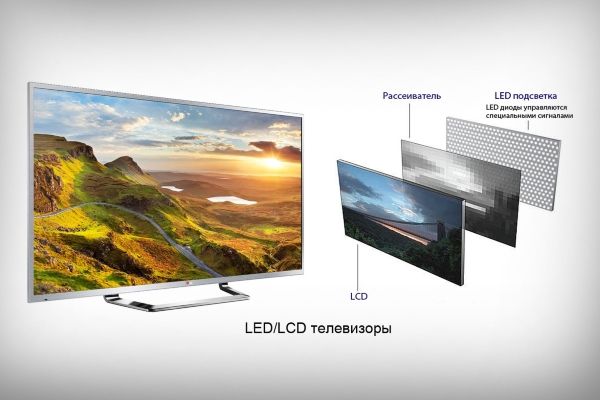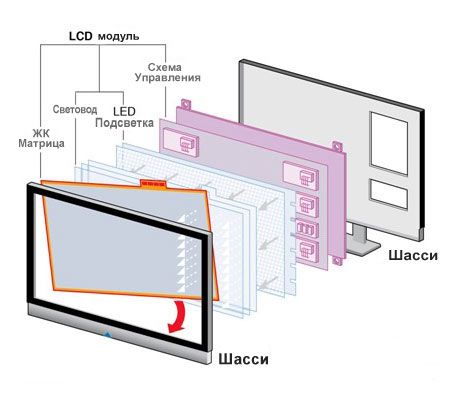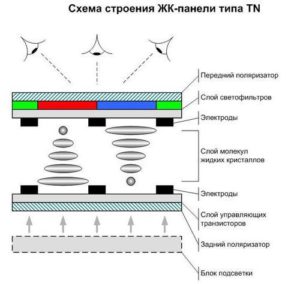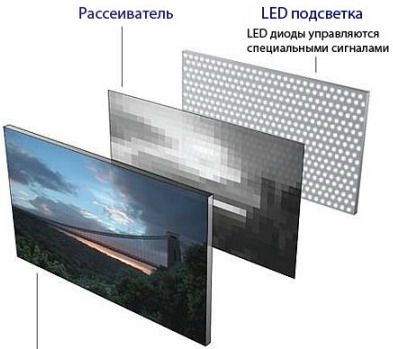What is a matrix on a TV
When buying a new TV, we don’t always think about what type of matrix is installed in it. And today there are several varieties of them (TN, IPS, VA). And such important characteristics of the TV as refresh rate, viewing angle, clarity and brightness of the picture depend on it. In order to make the right choice that corresponds to the assigned tasks and situation, it does not hurt to at least superficially understand what types of matrices there are and how they differ.

The content of the article
TV matrix - what is it?
The matrix is the main element of a multimedia device. The technology involved in production directly affects the quality of the picture. At the moment there are 3 main types of it:
- LCD (Liquid Crystal Display), also known as LCD displays. The principle of their operation will be discussed below.
- LED (Light-Emitting Diode). In this case, this is the type of backlight for LCD screens.
- plasma. A fundamentally different technology, it uses gas, which emits light when current passes through it.
At the moment, liquid crystal displays, due to their low cost and energy savings, have almost completely replaced plasma displays from the market. There are several types of LCD matrices. And despite the fact that they use the same properties of liquid crystals, their image quality and price are very different.
REFERENCE.Relatively recently, new OLED technology appeared, but at the moment such TVs are too expensive and belong to the premium class.
LCD matrix technology
The main element of every LCD matrix is the so-called liquid crystal. It has a special property - under the influence of an electric current, it changes the orientation of its molecules in space. This allows you to control with the help of current its ability to transmit or retain color
The LCD matrix used in modern TVs consists of several components:
- Layer of liquid crystals.
- Transparent electrodes. Located on both sides of the crystal layer, they control their ability to transmit light.
- Color filter. The layer responsible for the pixel color.
- Display backlight. Located at the back of the matrix.
- Glass or film covering the front part.
The operating principles of an LCD display are based on a crystal through which current flows from the electrodes. This changes the molecular structure of the crystal, as a result of which the light that passes through it breaks and hits the filter. As a result, we have a dot of the desired color on the screen.

Types of LCD TV matrices
At the moment, there are three main types of matrices operating on liquid crystals. Although their operating principles are similar, the picture quality and their prices are very different.
The main types of this technology include:
 TN (Twisted Nematic). Here the crystal molecule is twisted in a spiral, and when voltage is applied, it unwinds, thereby increasing the amount of light transmitted. The advantages of this approach include fast response time, low power consumption and affordable price. Its main disadvantage is the small viewing angle.
TN (Twisted Nematic). Here the crystal molecule is twisted in a spiral, and when voltage is applied, it unwinds, thereby increasing the amount of light transmitted. The advantages of this approach include fast response time, low power consumption and affordable price. Its main disadvantage is the small viewing angle.- VA (Vertical Alignment).The decoding of this abbreviation is “vertical alignment”, this well explains the principle of operation of this matrix. Here the crystals are positioned perpendicular to the color filters. When current is applied, they unfold, increasing their capacity and forming the color of the pixel. The advantages of this technology include good viewing angles and richer blacks. Among the disadvantages, we can note a slight deterioration in color when viewed from the side.
- IPS (In-Plane Switching). The most expensive, but at the same time the best technology in terms of viewing angles. Its peculiarity is the presence of electrodes on only one side. The main advantage of this type of matrix is the best color rendition among all, which has become a quality standard. Cons: large pixel size and response time, high price.
Each of these technologies has its own improvements that eliminate or significantly reduce disadvantages. Special films, voltage increases on the desired pixels and other additions help improve picture quality.
LED matrices
LED-based technology does not imply anything conceptually new in LCD displays. This is just a replacement of the backlight with fluorescent lamps CCFL, EEFL with LED Light-Emitting Diode. This approach allows you to organize the lighting of each pixel separately. This makes it possible to obtain high-quality black color.
IMPORTANT. LEDs, unlike fluorescent lamps, do not contain gases harmful to health. In addition, they consume significantly less electricity.
Today there are two types of LED backlighting:
- Along the edges of the screen (EDGE technology). This allows manufacturers to produce very thin displays.
- Over the entire area (DIRECT technology).Allows you to illuminate the center of the device more brightly and make larger screens.
LEDs are distinguished by their durability and operating efficiency, and also provide more uniform illumination.

How to determine the type of matrix on a TV?
The easiest way to determine the type of matrix is to look at the product packaging. The technology must be indicated there. Often the manufacturer puts a sticker on the TV that states the features and capabilities of the display. You can also look for a description of this model on the manufacturer’s website or other Internet resources.
There are several more ways to find out the type of matrix. They will help if the necessary information could not be obtained using the methods described above. This can be defined like this:
- Look at the screen at an angle. In the case of a TN display, the image will darken and colors will be distorted. With VA, the shades will become lighter, regardless of the viewing angle. In this case, the picture quality of the IPS screen will not change in any way.
- Press display. If it has an IPS matrix, the image will not be distorted.
- For damaged pixels. For IPS this area will be black, and for TN it will be white.
Using one of these methods, you can easily determine the type of matrix installed on the TV.
Which matrix is better on TVs?
The technology used in the TV directly affects the picture quality. To make the right choice, you first need to take into account your financial capabilities and equipment requirements.
So the most inexpensive option would be a media device with a TN matrix. In modern models, small viewing angles are partially compensated by additional film that expands them.
VA displays are suitable for connoisseurs of high-quality images.Although their price is higher than TN, they are a very popular choice for home cinema installations.
TVs based on IPS matrices are rightfully considered the best. The quality of their images is recognized as standard. Regardless of the lighting level and viewing angle, the picture remains unchanged. True, the price of such devices is not affordable for everyone.
Nowadays, the number of available technologies and solutions in the field of multimedia is growing rapidly. And sometimes making a choice is not so easy. The matrix is the most important element of any TV. And knowing the characteristics of each of its types will help you not to get lost among the variety that manufacturers offer us.






I think that for another 2 years people will use regular LED TVs, because they are cheaper than others and show well. My Phillips ice matrix works great with 4k movies!